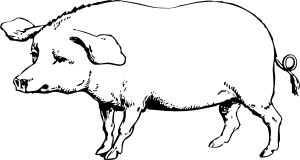

Before reading this post, you may want to read the introduction as well as parts one, two, three, and four.
Estimates vary widely on the percentage of global greenhouse gas emissions that come from the agricultural sector, but it’s certainly significant. Two factors make this sector especially critical in the battle against climate change. One is the fact that access to adequate food is more important than anything else for people trying to live through the coming hardships, even if many city people seem to overlook it. Food does not arrive in supermarkets by an alchemical transformation of money into food. There is a farm involved, or fishing.
The other critical factor is that the transformation we need in agriculture not only has the potential to drastically reduce the emissions of that sector; it actually has the potential to sequester large amounts of additional carbon. Not only that; regenerative farming, also known as agroecology, can safely sequester it and in doing so, actually improve the condition of the soil. Soils rich in carbon are rich in organic matter, which improves the friability of the soil and feeds the microorganisms—and in turn some bigger creatures like worms and bugs—that keep the soil, and the plants, healthy. Healthier plants, in turn, make for better health for the people or animals who eat them. There is no downside here, although there is dispute about how much carbon can actually be sequestered.
The elements of regenerative agriculture include avoidance of tilling, which disturbs those organisms and leads to erosion—but sometimes on large farms, this means the use of herbicides to replace tillage for weed control, and obviously herbicides don’t benefit those organisms. On smaller farms, weed control can be managed by hand-pulling and the use of mulch.
Other elements of regenerative farming include the use of compost, manure and mulch, all of which feed carbon into the soil, and leaving wild areas for plants that feed both pollinators and predator bugs. Growing multiple crops in proximity helps with pest control. Monoculture is responsible for the massive use of pesticides on industrial farms; a thousand acres of a single plant (usually a genetically identical strain of that plant) is an invitation to whichever pests target that plant. Using increasingly heavy doses of pesticide only fosters resistance on the part of the pest.
Similarly, ten thousand cows or pigs in one barn or feedlot, up to their hocks in their own manure, are such an invitation to their pests that CAFOs use antibiotics routinely (which may render them less effective in medical emergencies as many are also used by humans). But a small farm with livestock and crops, or multiple different crops, switched around from year to year, doesn’t extend that kind of invitation and thus is much less prone to serious pest attacks. The intact ecosystem with the weeds and trees and bugs and birds, keeps the pest bugs in check.
Cover crops to protect the soil against erosion, and often to feed the soil via nitrogen fixing, pulling up nutrients from subsoil, or simply biomass production, are another tool used by regenerative farmers. Ranchers who focus on raising cattle are finding that moving their animals frequently from one paddock to another can create improved soil at the same time the grass feeds their animals.
Some large farmers have been able to adopt these practices and improve their yields and their soil, sequestering carbon into the bargain. But often these methods are much more labor-intensive than the chemical- and machine-intensive style of what has come to be called conventional farming. The transition we need is likely to involve a lot more people working on farms.
But as with other sectors, there are also false solutions on offer. One of them is corn ethanol, which was supposed to create fuel with lower emissions than fossil fuel; it doesn’t, but lobbyists have kept the subsidies in place anyway, year after year.
Another false solution is genetically modified crops, with the newest branded as CRISPR crops. While it’s possible than these techniques could solve a problem in farming, they are poorly studied and likely to introduce unintended results. So far, the vast majority of GMO crops are engineered for resistance to herbicides sold by the same company. This may save the farmer time but it doesn’t improve yields or quality of the crop and leads predictably to enhanced resistance. GMO seeds have done much more for the bottom line of Monsanto than for farmers, much less consumers. There is evidence of harm to health from some of these crops, as well as from the glyphosate typically sprayed on Roundup Ready© crops.
The UN IPCC—Intergovernmental Panel on Climate Change—has a couple of new offerings of false solutions in the farming realm: BECCS and Climate Smart Agriculture. BECCS means Bio Energy Carbon Capture and Sequestration. The idea is that crops are grown, or trees cut, to burn for power; then the carbon dioxide is captured and buried. Trouble is, it would take such an enormous amount of land to produce a significant source of feedstock that either the food supply would be decimated, or the lands on which the remnant of wild creatures survive would be lost. Humanity now accounts for 36% of the mass of mammals and our livestock for 60%, leaving only 4% for all wild mammals. Much of this decimation has happened since 1970. This is not sustainable. Continued encroachment on the remaining wild lands is causing the destruction of indigenous peoples and also introducing novel viruses.
A similar approach is to burn wood pellets in old coal power plants, as is now being done in the UK and EU; this actually produces even more CO2 than the coal did, but the claim is that since the forest the pellets came from will grow back and sequester carbon again, therefore the emitted carbon doesn’t count. Nor, apparently, does the deforestation in the southeastern US, now supplying most of those pellets, or the trucking to a port and shipping across the ocean. The plants actually receive emission reduction credits for this! Sometimes an intact forest is cut and replaced with a tree plantation, basically a biological desert. There are schemes afoot to use GMO trees, including eucalyptus, which has caused drought problems and replacement of native species in Latin America. A frost-tolerant strain is being developed which could spread this problem to temperate zones, like the southern US.
Another forestry-related IPCC initiative is called REDD+, for Reduction of Emissions from Deforestation and Forest Degradation. The idea is that Northern governments or private outfits, often corporations in search of credits to “offset” their own emissions, pay governments in the global South to protect their forests, thus avoiding the emissions from deforestation. The problem here is that there may be little evidence that deforestation would have happened, or was avoided; in practice it may mean indigenous people who have lived in and protected the forest for millennia being kicked out…and after a time the forest may be cut anyway. The way to reduce emissions from burning fossil fuels in the North is to reduce the burning of fossil fuels in the North.
Climate Smart Agriculture is supposed to refer to any techniques that create the “triple win” of increased productivity, enhanced resilience, and reduced emissions. The problem here is that powerful interests push “solutions” that look suspiciously like the same old industrialized monocultures, now pushed across developing countries, often displacing peasants and subsidizing GMO crops, the glyphosate that goes with them, and expansion of the global mega-industrial food system that has no interest in feeding the hungry. As long as they use no-till, they can claim climate smarts—this is not progress.
There are also claims that producing and burying biochar can sequester enormous amounts of carbon, but the scientific evidence for this is scant.
The heart of the conflict between real solutions and false ones is no different here than with other sectors. The false solutions in each sector are aimed at maintaining current power relations. The real ones are aimed at rescuing ecosystems and leading to a better world for all humans and other life forms.
Read the final installment in this series here.









